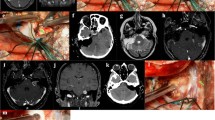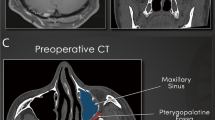Abstract
Evacuation of middle fossa trigeminal schwannomas (TS) warrants a subtemporal interdural approach through the lateral wall of the cavernous sinus (CS). The dura comprises the dura propria, which follows the trigeminal nerve and develops into the epineurium, and periosteal layer. The interdural approach involves peeling off the dura propria and exposing the epineural sheath. The venous route around the CS is often obstructed due to TS progression. The interdural approach based on venous route preservation remains to be discussed. The laterocavernous sinus (LCS) is formed in these layers, draining to either the medial or lateral route. In the lateral route, the LCS drains to the pterygoid plexus via the middle cranial fossa foramen. Exposure of the interdural space disturbs the lateral route’s venous flow. We describe an operative strategy for venous route preservation in TS via the LCS lateral route. The venous route can be preserved by peeling off the dura propria from the posterior end of the foramen ovale short of the venous drainage route to the pterygoid plexus epidurally and then cutting from the middle cranial fossa dura posterior to the venous route subdurally to the exposed interdural space. This technique helps in avoiding postoperative venous complications.





Similar content being viewed by others

References
Adachi K, Hasegawa M, Hayakawa M, Tateyama S, Hirose Y (2019) Susceptibility-weighted imaging of deep venous congestion in petroclival meningioma. World Neurosurg 122:e20–e31. https://doi.org/10.1016/j.wneu.2018.08.218
Adachi K, Hasegawa M, Hirose Y (2017) Evaluation of venous drainage patterns for skull base meningioma surgery. Neurol Med Chir (Tokyo) 57:505–512. https://doi.org/10.2176/nmc.ra.2016-0336
Adachi K, Hayakawa M, Ishihara K, Ganaha T, Nagahisa S, Hasegawa M, Hirose Y (2016) Study of changing intracranial venous drainage patterns in petroclival meningioma. World Neurosurg 92:339–348. https://doi.org/10.1016/j.wneu.2016.05.019
Adachi K, Kawase T, Yoshida K, Yazaki T, Onozuka S (2009) ABC Surgical Risk Scale for skull base meningioma: a new scoring system for predicting the extent of tumor removal and neurological outcome. J Neurosurg 111:1053–1061. https://doi.org/10.3171/2007.11.17446
Adachi K, Murayama K, Hayakawa M, Hasegawa M, Muto J, Nishiyama Y, Ohba S, Hirose Y (2020) Objective and quantitative evaluation of angiographic vascularity in meningioma: parameters of dynamic susceptibility contrast-perfusion-weighted imaging as clinical indicators of preoperative embolization. Neurosurg Rev. https://doi.org/10.1007/s10143-020-01431-y
Gailloud P, San Millan Ruiz D, Muster M, Murphy KJ, Fasel JH, Rufenacht DA (2000) Angiographic anatomy of the laterocavernous sinus. AJNR Am J Neuroradiol 21:1923–1929
Krogager ME, Jakola AS, Poulsgaard L, Couldwell W, Mathiesen T (2021) Safe handling of veins in the pineal region-a mixed method study. Neurosurg Rev 44:317–325. https://doi.org/10.1007/s10143-019-01189-y
San Millan Ruiz D, Gailloud P, de Miquel Miquel MA, Muster M, Dolenc VV, Rufenacht DA, Fasel JH (1999) Laterocavernous sinus. Anat Rec 254:7–12. https://doi.org/10.1002/(SICI)1097-0185(19990101)254:1<7::AID-AR2>3.0.CO;2-Y
Taptas JN (1982) The so-called cavernous sinus: a review of the controversy and its implications for neurosurgeons. Neurosurgery 11:712–717. https://doi.org/10.1227/00006123-198211000-00019
Yoshida K, Kawase T (1999) Trigeminal neurinomas extending into multiple fossae: surgical methods and review of the literature. J Neurosurg 91:202–211. https://doi.org/10.3171/jns.1999.91.2.0202
Youssef S, Kim EY, Aziz KM, Hemida S, Keller JT, van Loveren HR (2006) The subtemporal interdural approach to dumbbell-shaped trigeminal schwannomas: cadaveric prosection. Neurosurgery 59:ONS270–ONS277; discussion ONS277-278. https://doi.org/10.1227/01.NEU.0000227590.70254.02
Availability of supporting data
All data generated or analyzed during the study are included in this published article.
Author information
Authors and Affiliations
Contributions
All authors contributed to the study concept and design. Material preparation, data collection, and analysis were performed by Kazuhide Adachi, Mituhiro Hasegawa, and Yuichi Hirose. The first draft of the manuscript was written by Kazuhide Adachi, and all authors commented on the early versions of the manuscript. All authors read and approved the final manuscript.
Corresponding author
Ethics declarations
Ethics approval and consent to participate
This study was approved by the institutional review board of our hospital, and the patients were enrolled with informed consent, which included an explanation of the opportunity to opt out.
Human and Animal Ethics
This study was performed in line with the principles of the Declaration of Helsinki.
Consent for publication
The participants have all consented to submitting their case report for journal publication.
Competing interests
The authors declare no competing interests.
Additional information
Publisher’s note
Springer Nature remains neutral with regard to jurisdictional claims in published maps and institutional affiliations.
Supplementary Information
Operation video (Case 3). Following frontotemporal craniotomy, the middle meningeal artery was cauterized and cut at the foramen spinosum. Kawase’s triangle had already undergone osteolysis for tumor compression. First, the greater superficial petrosal nerve was preserved in the subperiosteal layer, and then the periosteal dura was peeled off from the foramen ovale to the superior orbital fissure depending on the tumor size. However, this maneuver disturbs the venous flow; therefore, we stopped just short of the foramen rotundum. The posterior fossa dura was opened, and a part of the trigeminal schwannoma within the posterior fossa was exposed. A cut was made from the middle cranial fossa dura posterior to the superficial middle cerebral vein and onwards to the exposed interdural space. The superficial middle cerebral vein was running in the interdural space. The perineural sheath of the trigeminal nerve in the interdural space and the cutline of the middle cranial fossa were connected. The dura propria was cut along the lateral side of the tumor. The fanning trigeminal nerve was located outside the tumor. The cerebrum tentorium was cut to expose the tumor. The fanning trigeminal nerve was separated from the tumor, and the tumor was removed. A final view of this operation is provided. The fanning trigeminal nerve remained, and the tumor was removed (MP4 292225 kb)
Rights and permissions
Springer Nature or its licensor (e.g. a society or other partner) holds exclusive rights to this article under a publishing agreement with the author(s) or other rightsholder(s); author self-archiving of the accepted manuscript version of this article is solely governed by the terms of such publishing agreement and applicable law.
About this article
Cite this article
Adachi, K., Hasegawa, M. & Hirose, Y. Epidural and subdural interdural approach to the lateral wall of the cavernous sinus for preserving the laterocavernous sinus in trigeminal schwannoma. Neurosurg Rev 46, 27 (2023). https://doi.org/10.1007/s10143-022-01934-w
Received:
Revised:
Accepted:
Published:
DOI: https://doi.org/10.1007/s10143-022-01934-w



